Everything You Need to Know About Writing Awesome Email Subject Lines
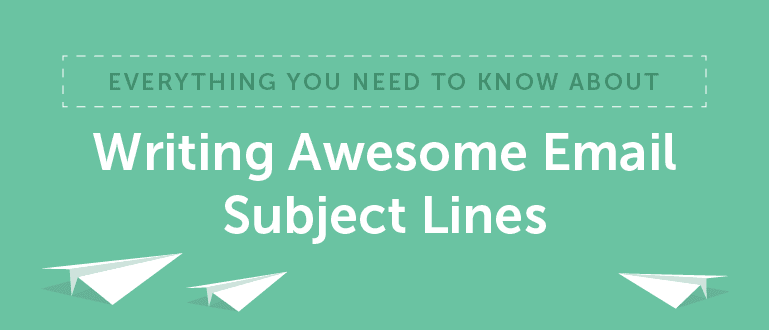 First impressions matter.
This is certainly true for email subject lines. They're the first thing recipients see in their inbox. When written well, they inspire readers to open your email newsletters and click through to read more. If they're off target, however, they let your reader know your email is a waste of time and space.
No pressure, though.
To make matters worse, we all get too many emails. Whether they're from a store you don't remember visiting, or your parents are wondering why you don't write more often (you should really drop them a line), the pursuit of inbox zero is a fabled achievement for knowledge workers (including marketers).
So, how do you write subject lines that make your emails stand out?
That's exactly what we'll cover in this post. You'll learn:
First impressions matter.
This is certainly true for email subject lines. They're the first thing recipients see in their inbox. When written well, they inspire readers to open your email newsletters and click through to read more. If they're off target, however, they let your reader know your email is a waste of time and space.
No pressure, though.
To make matters worse, we all get too many emails. Whether they're from a store you don't remember visiting, or your parents are wondering why you don't write more often (you should really drop them a line), the pursuit of inbox zero is a fabled achievement for knowledge workers (including marketers).
So, how do you write subject lines that make your emails stand out?
That's exactly what we'll cover in this post. You'll learn:
- The emotional elements of subject lines that drive clicks.
- Best practices on how to write subject lines.
- The best way to run A/B tests so you can gather your own data about what works best for you.
This Is How To Write Better Email Subject Lines To Get More Opens
Click To TweetSnag Your Email Subject Line Template + Resource Bundle ...
This post is packed full of advice. To make it easier to implement while you're on the job, we've rounded up these free templates:- Email Subject Lines Template: 43 fill-in-the-blank templates to practice sharpening your subject line writing skills.
- 500+ Power Words Cheat Sheet: We made this with headlines in mind, but the same words work to infuse emotion into subject lines, too.
- Power + Emotion Words Cheat Sheet: Another reference sheet loaded with emotional words to drive more engagement.
- Email Subject Line A/B Test Spreadsheet: A simple Excel file for storing the outcomes of your email subject line A/B tests.
... And Try Our New Email Subject Line Tester
You get one chance to write the perfect subject line for your email. Of course, there's no way to be sure how it'll perform until you hit "send." But, wouldn't be great if you could tilt the odds in your favor? That's where our Email Subject Line Tester comes in. Like our popular Headline Analyzer Studio, it's a simple tool for testing email subject lines. Enter your subject line: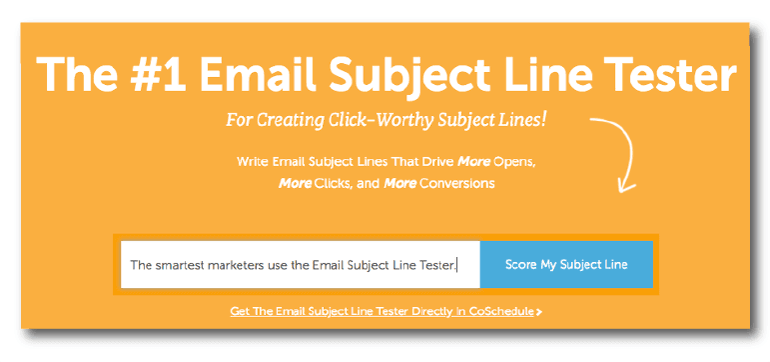 And get your score:
And get your score:
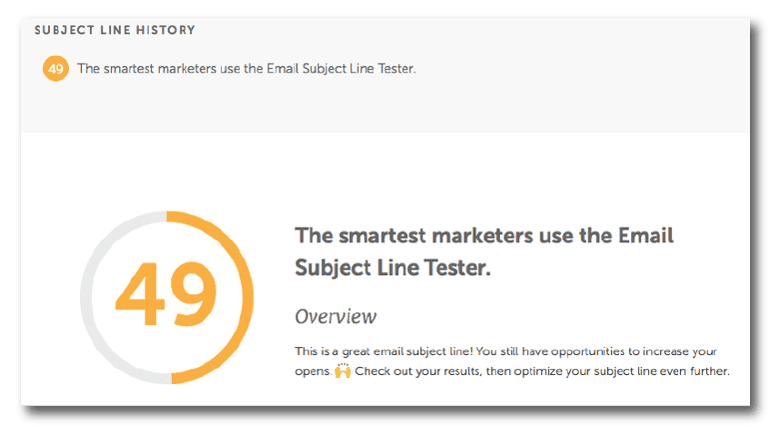 Plus, you'll get a detailed breakdown on how to improve your results:
Plus, you'll get a detailed breakdown on how to improve your results:
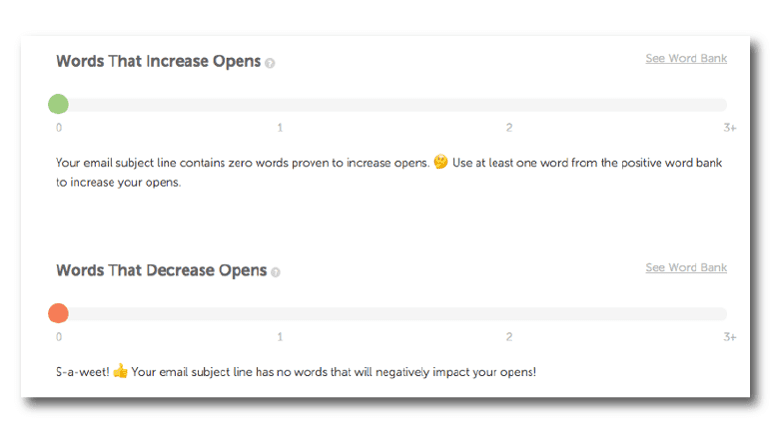 Give it a spin now and start optimizing every subject line you write (before sending it to your list).
Give it a spin now and start optimizing every subject line you write (before sending it to your list).
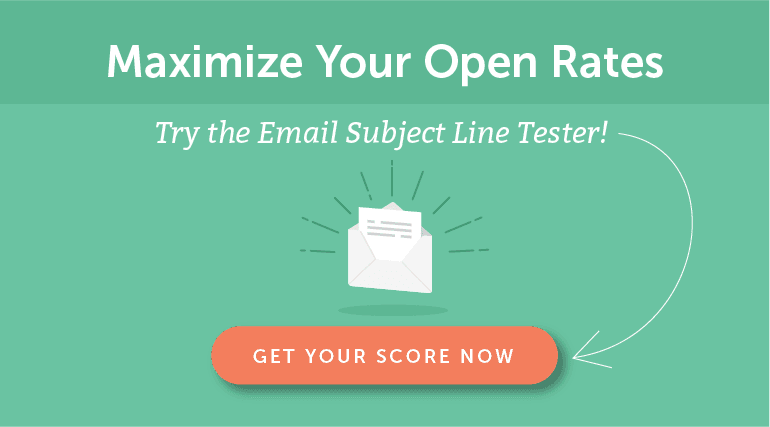
Why Are Subject Lines Important?
Like we stated previously, your subject line is the first thing recipients see. In that crucial make-or-break moment when users find your email in their inbox, it's what determines whether they'll click through, or simply ignore your message. Worse, they might even put your newsletter in the trash without even opening it up. Let's start by asking exactly why paying attention to subject lines is important. Here are some interesting stats: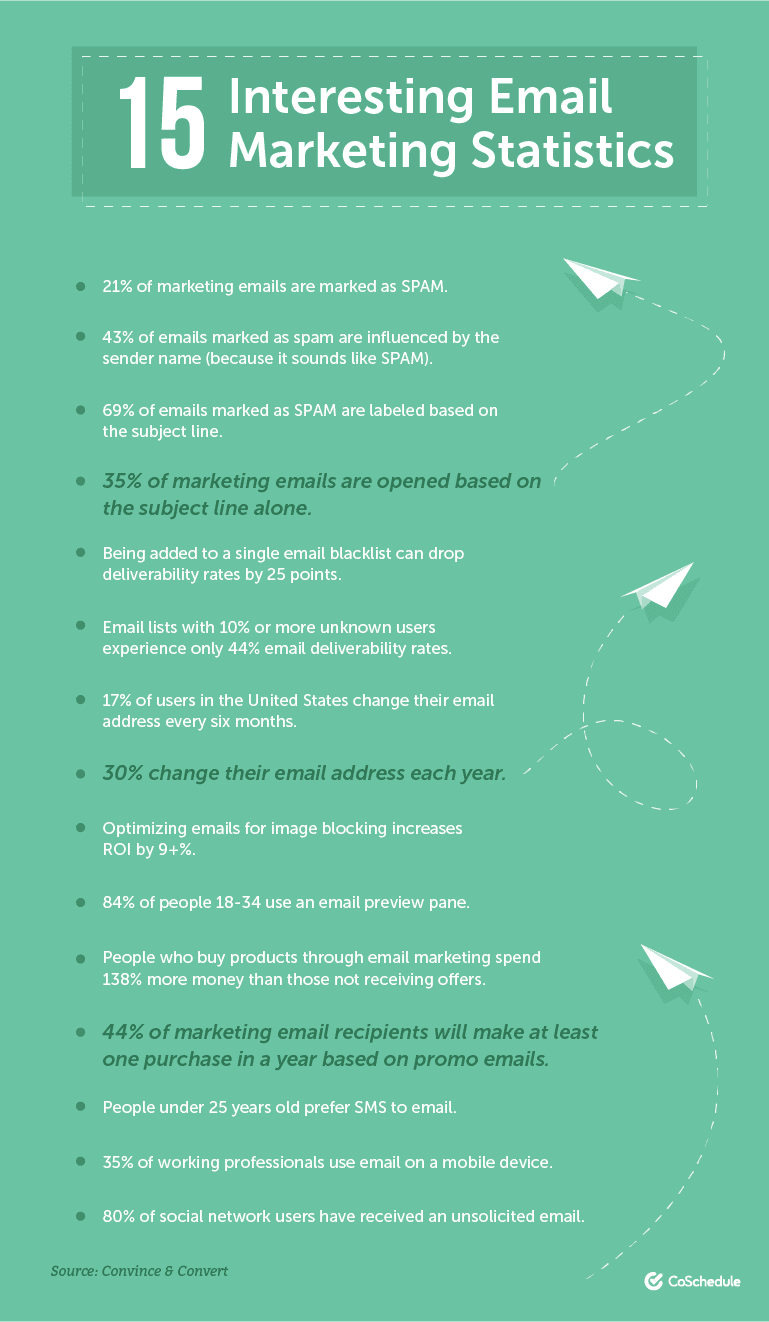 Source: Convince and Convert
When it comes to subject lines, these numbers tell us a few things:
Source: Convince and Convert
When it comes to subject lines, these numbers tell us a few things:
- Subject lines shouldn't sound overly sales-driven. No one wants to start their day with a blunt sales pitch. Stay out of SPAM folders by sounding natural.
- Avoid spammy-sounding subject lines. People will learn to avoid your emails, even if you make it into their inbox.
- Subject lines have a considerable influence on click-through rates. Sure, 35% isn't an astronomical number. However, it's high enough to show subject lines carry weight. Ignore them at your own peril.
Writing #email #subject #lines? Commit these three stats to memory.
Click To TweetCan You Show Me Some Examples of Great Email Subject Lines?
Now, you're probably wondering what good email subject lines look and sound like. There are a ton of great examples and resources out there, and we've rounded up some of the best below:- 101 Best Email Subject Lines of 2017 (Digital Marketer)
- 164 Best Email Subject Lines to Boost Your Email Open Rates (OptinMonster)
- 13 Insanely Clickable Email Subject Line Examples (Sumo)
- 40 Great Email Subject Lines (ThriveHive)
Three Mechanics of Strong Subject Lines
So, you've seen some examples of good subject lines. But, what actually makes them, well, good? Let's break down some mechanics.Write Short Subject Lines For Mobile Devices
According to MailChimp, there is little correlation between subject line length and clicks. However, keeping them short may help their appearance on mobile devices.Communicate a Clear Benefit
No one will open your marketing email if there is no benefit to the reader. So, make it clear that your recipient will gain something from opening it. In most cases, the benefit of your email will be clear. Here are some examples:- Move snow faster with this plow (benefit: clearing your driveway quicker).
- Cut grass like a champ (benefit: make lawn mowing easier).
- Improve your living room for 40% less (benefit: upgrade your furniture, saving money).
Use Words That Positively Impact Open Rates
The best subject lines use terms shown to drive action. Here's a quick look at 100+ words you should consider: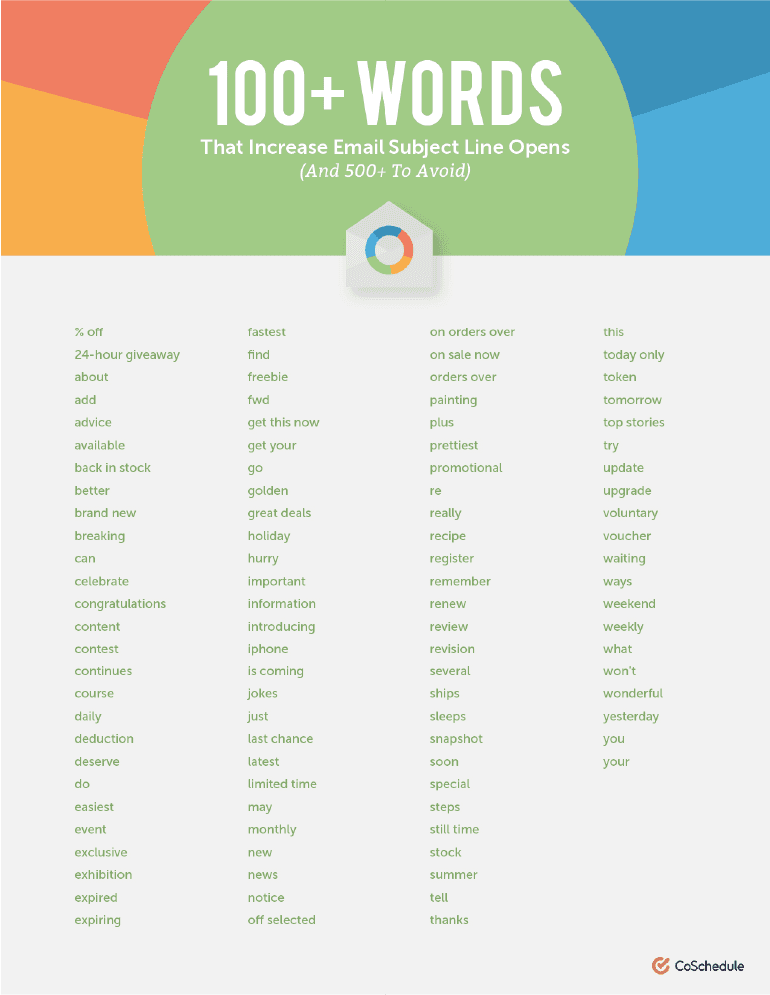
How Do Emotional Appeals Impact Email Open Rates?
Subject lines are a lot like headlines. The more emotional, the better. People want to know how their life will be better, easier, or more enjoyable because they read your email. Those kinds of benefits aren't necessarily easy to convey. However, they're essential for optimal open rates. So, how can you pull those emotional levers to get more opens? Start by understanding which emotions you want to invoke, and learn the language necessary to drive that action.Which Emotions Can Email Marketers Tap Into?
 So, we've established the need to give your emails some feeling. But, which emotions or sensations should marketers focus on eliciting? Let's focus on the following four:
So, we've established the need to give your emails some feeling. But, which emotions or sensations should marketers focus on eliciting? Let's focus on the following four:
- Urgency. Why should I act fast (and what will happen if I don't)?
- Curiosity. How can you include enough detail to get readers interested, but leave enough mystery that they have to click through?
- Excitement. Can your subject line hype up your email content (and can your newsletter can back it up)?
- Joy. What can your subject line do to promote a positive emotional result for your reader?
How to Write Subject Lines That Inspire Urgency
Let's take a look at some easy subject line formulas and templates you can use to get readers moving.Give Your Reader a Deadline to Act
Deadlines and "limited time" messaging can inspire immediate action. Example: Successful marketers will open this ... before time runs out.Tap into FOMO (The Fear of Missing Out)
The "fear of missing out" is real, and no one wants to miss out on something good. Example: Limited spots available! Claim yours now.Imply Negative Outcomes Due to Lack of Action
What happens if the recipient doesn't take advantage of what's in your email? Example: Don't let your lawn suffer under the summer sun.How to Write Subject Lines That Inspire Curiosity
Everyone enjoys a little bit of mystery from time to time, right? Here's how to infuse some suspense into your emails to get more opens.Try the Cliffhanger Approach
Leave out enough detail to stoke interest without telling the whole story. Example: Bob's lawn got greener than ever using ...Start With the End
Offer readers a conclusion that leaves them wondering how the story starts. Example: How did Bob's lawn get so green?Use an Open-Ended Question
One that can only be answered by opening your email. Example: What's new at Bob's Lawn Care Emporium?How to Write Subject Lines That Inspire Excitement
Get readers excited to open their email (or, well, as excited as you can get while reading email). Here's how to infuse some hype into your subject lines.Incorporate Strong Action Verbs
Use language that encourages people to get up and do something. Example: Blast your abs for less at Dave's GymGive Your Reader a Sense of Exclusivity
Email subscribers love feeling like they have the inside track on exclusive deals and information. Example: Can you keep a secret? Here's some cool news coming soon ... Make an Offer People Can't Refuse Use an accurate but hard-to-believe statistic or incredible offer to generate excitement. Example: Did you know 73% of clients see improvement using this tactic?How to Write Subject Lines That Inspire Joy
You know the saying, "People won't remember what you say, but they'll remember how you made them feel?" That absolutely applies to marketing, your brand, and your email subject lines. Make people feel good and reap the rewards.Use Emojis Intelligently
A well-placed emoji can be great for getting a chuckle. Example: Look your best and feel your best :) (this isn't the best example, but pretend that smiley face is a much cooler-looking emoji)Work In Humor (Carefully)
Laughter is good for your health. Put people in a good mood, and they'll react more positively to your content. Example: So three marketers walk into a bar ...Give People an Opportunity to Do Good
Because it feels good to do good. Example: Make a difference with us for our local animal shelterApply Your Knowledge: Write Better Subject Lines in Six Steps
It's time to take what you've learned and put it into action. Follow these steps to start writing.
Identify the Topic and Purpose of Your Email
What is your email newsletter about? Here are some common possibilities:- Promoting a sale.
- Sharing your most recent content.
- Announcing a new product launch.
- Offering helpful how-to tips.
- Getting event registrants.
Know Your Audience
If you're doing marketing correctly, you should know who your audience is. But, your audience may be comprised of several different market segments. So, make sure you know exactly who you're targeting. Then, craft messaging that will appeal to them.Identify Your Benefit or Value Proposition
Why would someone open this email? Think about what's in it for your reader, as much as what's in it for your brand. Some examples could include:- Saving money.
- Completing a task more easily.
- Doing something charitable.
Pick Your Emotional Appeal
Remember Urgency, Curiosity, Excitement, and Joy? Choose one to focus on. Or, consider writing several options targeting different emotional appeals. Whichever you choose, have clear intent behind your words.Match the Message in Your Email Copy
Message-match means making sure your subject line aligns with your email's content. Typically, it's a term reserved for digital advertising, ensuring ad copy aligns with a landing page. But, we can apply the same principle here. For example, if you're promoting a sale, make sure your subject line and body copy are consistent with one another. If you're promoting a piece of content, make sure your subject line's message matches what they'll find on the destination page.Write Several Options With the Email Subject Line Tester
It's a good idea to try tons of different options before settling on one subject line. If you're writing for a client, you might even give them five or six to choose from. As you write different options, the tester will keep track of your scores: Plus, the tool will help you learn what works (and what doesn't). It's an easy way to
Plus, the tool will help you learn what works (and what doesn't). It's an easy way to
Ten Templates to Write Your Own Email Subject Lines
As an exercise, try filling in these templates. Then, use the Email Subject Line Tester to see how your efforts perform.- The best [AUDIENCE] are using this [TACTIC] to [BENEFIT]
- Do [ACTION] [PERCENT] better
- Save [PERCENT] on [PRODUCT] before [NEGATIVE CONSEQUENCE]
- [NUMBER] Ways to [BENEFIT] Using [PRODUCT]
- Achieve [GOAL] [PERCENT] Faster With [PRODUCT]
- Help [ORGANIZATION] do [BENEFIT] before [DEADLINE]
- The smartest [AUDIENCE] will be at [EVENT] ...
- Register for [EVENT] by [DEADLINE] and save [PERCENT]
- Here's how [INFLUENCER] does [ACTION] with [PRODUCT]
- [NUMBER] secrets the best [AUDIENCE] use to [BENEFIT]
Get More Opens By A/B Testing Email Subject Lines
Nearly every email service provider lets you send A/B tests for your email subject lines. Whether you use MailChimp, Campaign Monitor, or something similar, most provide A/B testing options when building email newsletters. This video is specific to MailChimp, but it covers a lot of A/B testing basics that should apply to most platforms:5 Effective Tactics for Email A/B Testing
The key to a good A/B test is to choose variables that really are different from one another. If you test two subject lines that sound too similar, you won't learn much. There needs to be a substantial difference between your two options. Consider these five different approaches when you run your next A/B test:1. Test Two Different Value Propositions
Let's say your email content is promoting a post that both:- Shows readers how to save time.
- Shows them how to save money.
The key to a good A/B test is to have options that are different from one another.
Click To Tweet2. Target Two Different Emotions
Your audience might respond better to curiosity than urgency. Or, maybe they're looking for something that will brighten their day. So, find out. Try targeting different emotions and see what drives a better response.3. Test Subject Line Length
You might find different subject line lengths work best for you. Or, different lengths may work better for different types of messages. Consider experimenting with short (one or two words) versus long (seven or eight words).4. Test Questions Versus Definitive Statements
Questions can help get readers curious. However, definitive statements can express authority. Try both and see what happens.5. Test Using Stats
Statistics can drive email opens, especially when they're difficult to believe. If your email content includes an interesting stat, try incorporating one into subject line A. Then, write subject line B without a stat.Now, An Exercise In A/B Testing
Now, let's try applying what you've learned to an actual A/B test.Write Your Email Content
Start by writing your email copy. This will make it easier to write your subject lines.Identify Which Two Variables You'll Test
Write two different subject line options. Try to emphasize something different in each one. For example, you could target two different emotions, in order to sell people on reading the same newsletter. Or, you could include an emoji or statistic in one, but not the other. Whichever you choose, the point is to know exactly what you're testing.See Which Does Best
Once your email has sent, you'll see relatively quickly which outperformed the other. Use the Email A/B Subject Line Testing template we included in this post to track performance over time: Here are some specific things to monitor:
Here are some specific things to monitor:
- Winning and Losing Subject Lines: Which options perform best? Do certain types appear to fail more frequently than others?
- Open Rates: How many people opened each email?
- CTR (Click-Through Rate): How many people click through on each subject line?
Measure Your Results
Use the analytics tools built into your email platform to monitor open rates. Use the template included in this post, or create your own following the graphic below. Use it to track your winner and loser from the test, the difference in the results, and scrutinize the reason why your winner performed the best. This may require some subjective judgment. When assessing the reason one subject line outperformed the other, keep the following in mind:
When assessing the reason one subject line outperformed the other, keep the following in mind:
- If you set up clear variables in your A/B test, the reason subject lines succeed or fail should be obvious. For example, if one option includes a statistic, while the other does not, then that's a good indicator that stats resonate with your audience.
- Look for patterns. The more you test, the more consistent patterns should emerge.
- The days and times you send email can impact results as well.
- Remember that the actual content of your email may influence open rates (and in turn, your email conversion rates, too. If people aren't interested in the topic of your email, then simply following best practices might not be enough to drive opens and clicks. Great content will get attention. Following proper mechanics and technique merely maximizes great content's ability to make an impact.
- When it comes to email marketing, your own data beats best practices. The recipients on your email list are different from anyone else's. What works for another business, might not work for yours. This is why it's better to know how to gather your own data than to simply follow someone else's.
Don't use other's data as your guide. Use it to inspire you to get your own data.
Click To TweetNow, Go Write Better Subject Lines!
It's easy to overlook subject lines when we're writing marketing emails. They're short, so they should be easy, right? Not exactly. It's often tougher to write short, punchy messages than long, rambling pieces. When you only have about 50 characters to work with, every word counts. We can't tell you exactly what messaging will work best in your email. However, you're now equipped with the knowledge you need to start experimenting with your own subject lines. By following the tips and best practices in this post, you'll be able to dramatically increase your odds of success. Try different things. See what works. Ditch what doesn't. Repeat for success.Test #email subject lines. See what works. Ditch what doesn't. Repeat for success.
Click To Tweet This post was originally published on April 20, 2016. It was updated and republished on March 19, 2018.
This post was originally published on April 20, 2016. It was updated and republished on March 19, 2018.

